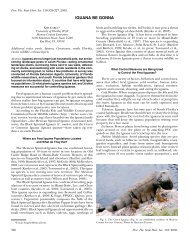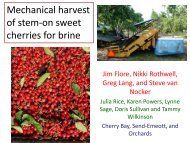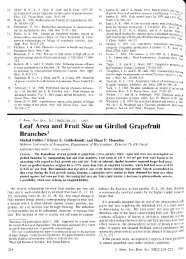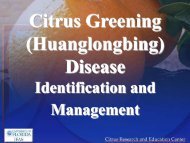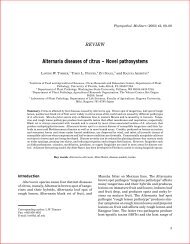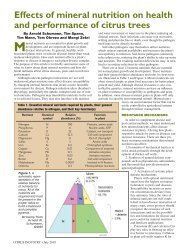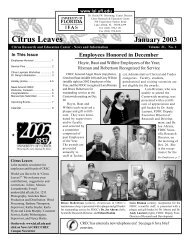management of melon thrips, thrips palmi karny - Citrus Research ...
management of melon thrips, thrips palmi karny - Citrus Research ...
management of melon thrips, thrips palmi karny - Citrus Research ...
Create successful ePaper yourself
Turn your PDF publications into a flip-book with our unique Google optimized e-Paper software.
ters. The soil was Krome gravely loam at the Tropical <strong>Research</strong><br />
and Education Center, Homestead, Fla. Two weeks<br />
prior to setting transplants the beds were fumigated with MC-<br />
33 (67% methyl bromide and 33% chloropicrin) at 220 lb/<br />
acre. Each bed was supplied with one drip irrigation line and<br />
covered with 1.5-mil thick black polyethylene mulch. Cucumber<br />
plants were drip-irrigated twice daily. Fertilizer (N-P-K<br />
mix) was applied at 200-50-240 lb/acre. Weeds were controlled<br />
by soil-incorporating trifluralin (Treflan EC, 24 lb/<br />
acre) at 10 d before planting, supplemented during the middle<br />
<strong>of</strong> the season with mechanical cultivation. The treatment<br />
plots consisted <strong>of</strong> three rows each 30 ft. long. The plots were<br />
arranged in a randomized complete block design with four<br />
replications. A 5 ft.-wide buffer <strong>of</strong> bare soil separated each<br />
replication. Treatments evaluated in this study were: 1) two<br />
rates <strong>of</strong> emamectin benzoate (Proclaim® 5%, 0.1 and 0.15 lb.<br />
a.i./acre, Syngenta Crop Protection, Greensboro, N.C.), 2)<br />
spinosad (Spintor 2SC, 0.11 lb. a.i./acre, Dow AgroSciences<br />
LLC, Indianapolis, Ind.), and 3) a nontreated control. All<br />
insecticides were applied to the foliage on three dates- 17, 27<br />
June and 6 July, 2004 using a backpack sprayer with two nozzles<br />
per row at 30 psi delivering 70 gal/acre. There was no<br />
phytotoxicity with any <strong>of</strong> the treatments. Evaluation <strong>of</strong> treatments<br />
was conducted 24 h after each application by collecting<br />
five randomly selected leaves, one leaf per plant per treatment<br />
plot. Leaves were placed in ziplock bags, transported to<br />
the laboratory and washed with 70% ethanol to separate <strong>melon</strong><br />
<strong>thrips</strong> adults and larvae.<br />
Third study. The third study was conducted in 2005 in a research<br />
plot at the Tropical <strong>Research</strong> and Education Center using<br />
‘Greensleeves’ cucumber as a host crop. All materials and<br />
methods involved in this study were as described in the second<br />
study in cucumber in 2004. The seven treatments evaluated in<br />
this study were: 1) two rates <strong>of</strong> azadirachtin (Aza-Direct<br />
1.2(%), 0.012 and 0.016 lb. a.i./acre, Gowan Company, Yuma,<br />
Ariz.); 2) imidacloprid (Admire 2F, 0.25 lb. a.i./acre, Bayer<br />
CropScience, <strong>Research</strong> Triangle Park, N.C.) at planting as a<br />
soil drench followed by foliar application <strong>of</strong> two rates <strong>of</strong> azadirachtin<br />
(Aza-Direct 1.2(%) at 0.012 and 0.016 lb. a.i./<br />
acre. 3) imidacloprid alone at 0.25 lb. a.i./acre as a soil<br />
drench at planting; 4) spinosad (Spintor 2SC, 0.13 lb. a.i./<br />
acre, Indianapolis, Ind.); and 5) a nontreated control.<br />
Fourth study. In the fourth study, eight treatments with various<br />
formulations <strong>of</strong> azadirachtin (Aza-Direct 1.2(%). Ecozin®<br />
3.0 and Neemix® 4.5) were evaluated to control T. <strong>palmi</strong><br />
on cucumber. ‘Greensleeves’ cucumber was seeded in a<br />
Krome gravely loam soil on 28 Mar. 2005. Crop <strong>management</strong><br />
and insecticide application and efficacy evaluation methods<br />
were as described in above studies using cucumber. Treatments<br />
evaluated in this study were: 1) three rates <strong>of</strong> azadirachtin<br />
(Aza-Direct 1.2 [%] 0.004, 0.006 and 0.012 lb. a.i./acre),<br />
2) four rates <strong>of</strong> azadirachtin (Ecozin® 3% EC, 0.009, 0.012,<br />
0.015 and 0.018 lb. a.i./acre) in combination with vegetable<br />
oil-surfactant (Amigo, 1% v/v, Loveland Industries, Colo.),<br />
3) azadirachtin (Neemix® 4.5, 0.009 lb. a.i.; Certis USA, Columbia,<br />
Md.), and 4) a nontreated control. Treatments were<br />
applied on five dates between 25 April and 24 May. Treatments<br />
were evaluated for degree <strong>of</strong> controlling <strong>of</strong> T. <strong>palmi</strong> 24<br />
h after each application, i.e., on 26 April, 2, 12, 19 and 23 May.<br />
Data Analysis. Data were analyzed using s<strong>of</strong>tware provided<br />
by Statistical Analysis System release 6.03 (SAS Institute, Inc.,<br />
Cary, NC; SAS Institute, 1988). General linear model procedures<br />
were used to perform analysis <strong>of</strong> variance. Means were<br />
separated by Duncan Multiple Range Test (DMRT) at the<br />
0.05 level.<br />
Results and Discussion<br />
The population abundance <strong>of</strong> the <strong>melon</strong> <strong>thrips</strong> was low<br />
during the first study. None <strong>of</strong> the insecticide treatments provided<br />
any reduction <strong>of</strong> <strong>melon</strong> <strong>thrips</strong> adults when compared<br />
with the nontreated control (Table 1). Knack® alone,<br />
Knack® plus Orthene®, and Knack® plus Danitol® provided<br />
control <strong>of</strong> <strong>melon</strong> <strong>thrips</strong> larvae when compared with the nontreated<br />
control (Table 2). Also Danitol® + Orthene® significantly<br />
reduced <strong>melon</strong> <strong>thrips</strong> larvae when compared with the<br />
nontreated control.<br />
In the second study on cucumber, Proclaim® and Spintor®<br />
treatments significantly reduced <strong>melon</strong> <strong>thrips</strong> adults<br />
and larvae (Table 3) when compared with the nontreated<br />
control (Table 4). Mean numbers <strong>of</strong> <strong>melon</strong> <strong>thrips</strong> adults and<br />
larvae did not differ between two rates <strong>of</strong> Proclaim®. Spintor®<br />
at 7 oz/acre provided superior reduction <strong>of</strong> <strong>melon</strong><br />
<strong>thrips</strong>.<br />
In the third study, Aza-Direct treatments significantly<br />
reduced <strong>melon</strong> <strong>thrips</strong> adults on cucumber on all sampling<br />
dates when compared with the nontreated control (Table 5).<br />
Aza-Direct alone did not reduce <strong>melon</strong> <strong>thrips</strong> larvae when<br />
compared with the control (Table 6). Aza-Direct at 21.5<br />
oz./acre preceded by Admire® at planting provided significant<br />
reduction <strong>of</strong> <strong>melon</strong> <strong>thrips</strong> larvae when compared with<br />
the nontreated control. Spintor® significantly reduced mel-<br />
Table 1. Mean numbers <strong>of</strong> Thrips <strong>palmi</strong> adults per 20-leaf sample <strong>of</strong> bush bean treated with various insecticides in 2003.<br />
Treatment<br />
Rate per acre<br />
Mean number <strong>of</strong> T. <strong>palmi</strong> adults<br />
25 Mar 03 2 Apr 03 9 Apr 03 16 Apr 03<br />
Overall<br />
mean<br />
Knack® 8 oz 2.40 a 0.80 a 0.55 a 0.45 a 1.05 a<br />
Knack® 8 oz 1.40 a 0.95 a 0.60 a 0.95 a 0.98 a<br />
Orthene®<br />
0.75 lb a.i.<br />
Knack® 8 oz 2.10 a 1.15 a 0.65 a 0.80 a 1.18 a<br />
Danitol®<br />
0.30 lb a.i.<br />
Danitol® 0.30 lb a.i. 2.35 a 1.30 a 0.55 a 0.45 a 1.16 a<br />
Orthene®<br />
0.75 lb a.i.<br />
Admire® 16 oz 1.60 a 1.20 a 0.80 a 0.55 a 1.05 a<br />
Control 2.00 a 1.45 a 0.80 a 0.45 a 1.18 a<br />
Means within a column followed by the same letter or no letter do not differ significantly (P > 0.05; DMRT).<br />
120 Proc. Fla. State Hort. Soc. 118: 2005.



